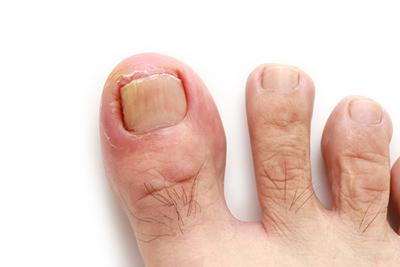Symptoms of an Ingrown Toenail

- posted: Apr. 01, 2024
Ingrown toenails are painful and ugly. They can make it difficult to put on shoes, to stand, and to walk without pain. An ingrown toenail can decrease your mobility. Your podiatrist can help you get rid of ingrown toenails and teach you tips on how to prevent ingrown toenails in the future.
What You Need To Know About an Ingrown Toenail
An ingrown toenail is a toenail that has begun to grow into the surrounding skin. An ingrown toenail can be caused by cutting your toenails too short, rounding the corners of your toenails when you cut them, or having toenails that naturally curve under. When you have an ingrown toenail you may:
- Notice redness, bruising, and swelling around the toenail
- Feel pressure and pain underneath your toenail
- See blood or pus coming out from around the toenail
If you are experiencing an ingrown toenail, you may be able to get relief if you:
- Soak your toe in warm water for several minutes
- Place dental floss underneath your nail to guide the toenail back up and off the skin
- Apply antibiotic cream around your toenail
- Bandage your toenail to protect it
- Wear open-toe shoes until your toe heals
For moderate to severe ingrown toenail symptoms, you should see your podiatrist, who may recommend:
- Shaving or trimming your toenail to reduce pressure
- Lifting the toenail to allow it to grow freely
- Removing the toenail completely so a new, healthy toenail can grow
Remember that you can do a lot to prevent ingrown toenails. You need to:
- Cut your toenails straight across, with no rounded corners
- Avoid cutting your toenails too short
- Wear shoes with plenty of toe room, so your toes aren’t crushed together
Want To Know More About Ingrown Toenails and Ingrown Toenail Treatment?
To learn more about the causes, signs, symptoms, treatment, and prevention of ingrown toenails, talk with your podiatrist today.

- posted: Apr. 01, 2024
Ingrown toenails are painful and ugly. They can make it difficult to put on shoes, to stand, and to walk without pain. An ingrown toenail can decrease your mobility. Your podiatrist can help you get rid of ingrown toenails and teach you tips on how to prevent ingrown toenails in the future.
What You Need To Know About an Ingrown Toenail
An ingrown toenail is a toenail that has begun to grow into the surrounding skin. An ingrown toenail can be caused by cutting your toenails too short, rounding the corners of your toenails when you cut them, or having toenails that naturally curve under. When you have an ingrown toenail you may:
- Notice redness, bruising, and swelling around the toenail
- Feel pressure and pain underneath your toenail
- See blood or pus coming out from around the toenail
If you are experiencing an ingrown toenail, you may be able to get relief if you:
- Soak your toe in warm water for several minutes
- Place dental floss underneath your nail to guide the toenail back up and off the skin
- Apply antibiotic cream around your toenail
- Bandage your toenail to protect it
- Wear open-toe shoes until your toe heals
For moderate to severe ingrown toenail symptoms, you should see your podiatrist, who may recommend:
- Shaving or trimming your toenail to reduce pressure
- Lifting the toenail to allow it to grow freely
- Removing the toenail completely so a new, healthy toenail can grow
Remember that you can do a lot to prevent ingrown toenails. You need to:
- Cut your toenails straight across, with no rounded corners
- Avoid cutting your toenails too short
- Wear shoes with plenty of toe room, so your toes aren’t crushed together
Want To Know More About Ingrown Toenails and Ingrown Toenail Treatment?
To learn more about the causes, signs, symptoms, treatment, and prevention of ingrown toenails, talk with your podiatrist today.
